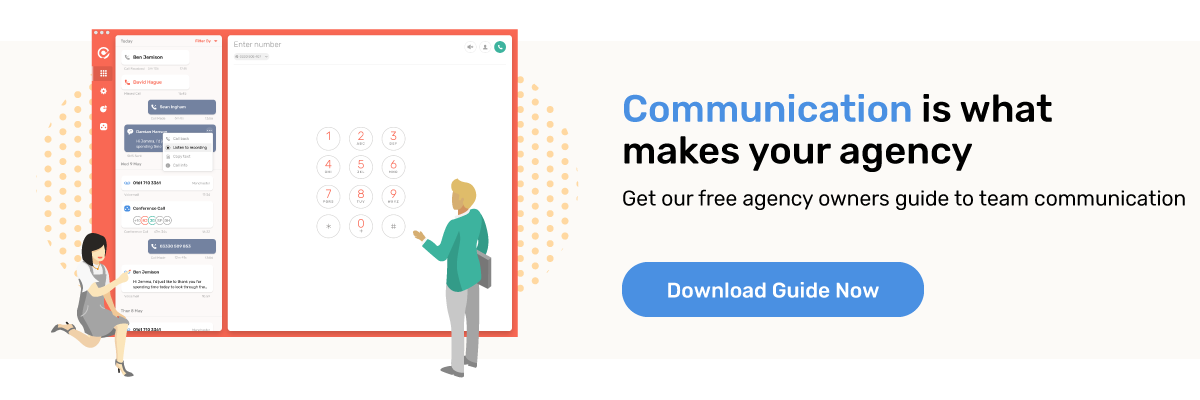Good, efficient internal communication is usually the glue that holds a business together. Without this glue, things can get a little sloppy. Tasks start to fall between the cracks, deadlines are missed and before you know it, the blame game begins and your company starts to fall apart.
Okay, your company might not fall apart but things will definitely get a little tense.
You might already have a communication strategy in place but how can you be sure that it’s working? Here are some signs that indicate it’s time your agency needs a proper internal communication strategy, plus how to implement one.

1. Endless Email Chains
Emails are essential for communicating internally with a company or externally to clients, customers and stakeholders. But they’re not always efficient, especially if you’re relying solely on them.
It’s far too easy to become a part of an endless email chain and before you know it, your inbox is overflowing. If one day you need to find a particular email, you’ll be combing through this mountain of emails just to find that one. Which isn’t much fun. Or efficient.
2. Files Stored All Over the Place
Whether it’s as important as sensitive company data or a simple spreadsheet template, all of your files need to stored in their appropriate folders. If your files are stored in random locations with no sense of logic, you’re going to find it very tricky to find anything you want. Especially as more and more people join your team.
3. Your Team Keep Missing Meetings or Calls
If your team constantly keep missing meetings or conference calls, it might be because they don’t actually know they have a meeting or conference call to attend. And that means your internal communication tactics need some refining.
4. Client Calls and Meetings are Booked But the Employee is Off
Are you finding that employees are booking client calls and meetings and then keep missing them because they’re out of the office? Then you might have an internal comms issue on your hands.
It’s fine to have an emergency day off (such as being ill), but if your employees don’t turn up to a meeting that they’ve organised because they’re on holiday and your team haven’t prepared for their absence, it certainly won’t impress your client. Nor will it bode well for your company’s professional reputation.
5. Internal Comms Tools are Out of Control
The great thing about internal communication tools, like Slack, is that they’re better for teamwork than email. Unlike emails where threads would get too long, tools like Slack are basically instant message chat apps. You can create multiple chat rooms or channels for different groups of people. It’s much easier to check conversation histories and group participation.
But, it’s also too easy to let these office IM tools turn into a distraction. People may start to talk about non-work related topics too often and it may affect productivity.
6. Vague or Conflicting Orders from Management
If your employees are becoming confused because the management team are giving them conflicting orders and requests, it’s time to sharpen up your internal comms strategy before any lasting damage is made. This especially applies to remote workers who won’t have their bosses on-hand to guide them or correct mistakes in person.
7. Employee and Company Goals are Misaligned
Your employees need to know what your company’s goals are if they’re to know what they’re working towards every day. If they don’t, how can you expect them to help you get there?
The key is communicating your message early and often. Don’t be afraid to repeat yourself as it’s vital your employees are listening to you rather than tuning you out. Internal communication tools can help you with this.
8. High Turnover Rate
If your company has retention issues, it might be because your internal communication strategy isn’t as effective as it should be. People often leave companies because they feel insignificant, unimportant, taken for granted or not given the recognition they deserve.
Don’t just keep your employees in the loop with important company decisions. Keep them in the loop with the why behind the decisions. Sharing “high level” information like this is extremely effective for creating purpose and kickstarting a sense of camaraderie in teams.
So, What Can I Do to Improve My Internal Communication Strategy?
Ultimately, a poor internal communication strategy will affect a company’s overall productivity level. Luckily, there are ways to improve this.
Know What’s in a Comms Plan
- The current situation of your company.
- What you want to achieve (company goals).
- Who you want to talk to and connect with (your company’s audience).
- What you want to say (your company’s core values and messages).
- How you’re going to communicate (internal and external comms).
- When you’re going to communicate.
- How you’re going to measure your progress and success.
Know What Tools You’re Going to Use
Once you know what’s going into a communication strategy, the next logical step is to choose the right tools to help you execute everything. Will you be relying on emails, turning to Slack or will you be using a mixture? Or, will you be trying out something new like an app-based business phone?
With app-based phone systems, you no longer need to set up the traditional business phones with their clunky headsets and wires. You can use your personal mobile, laptop or other devices as the phone. All you need is an app to get you started.
For instance, CircleLoop allows you to choose from a huge range of local, national and international numbers so you could be sitting on your sofa while your client thinks you’re in a slick office in San Francisco. Plus, there are a whole host of other features, from call recording to the ability to redirect calls to a backup number if you have no WiFi.
Want to Find Out More About Agency Comms?
Internal communication strategies aren’t the only thing you need to know when it comes to team communication. If you want your agency to really smash comms out of the park, take a look at our guide to team communication. From internal to external comms, it can help any agency owner learn everything they want to know about team communication.
Download it below.
.png)



